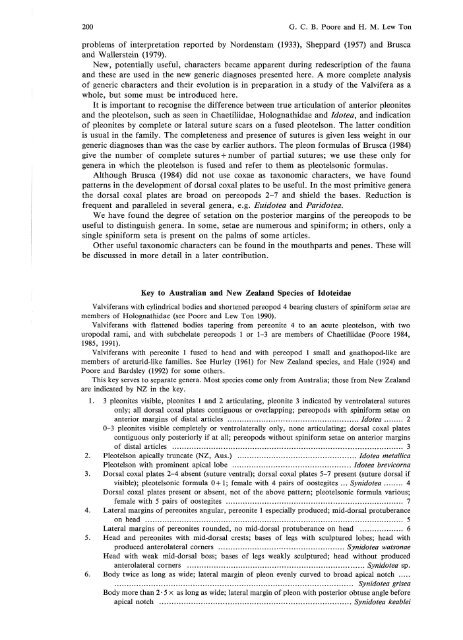Idoteidae of Australia and New Zealand (Crustacea: Isopoda: Valvif ...
Idoteidae of Australia and New Zealand (Crustacea: Isopoda: Valvif ...
Idoteidae of Australia and New Zealand (Crustacea: Isopoda: Valvif ...
You also want an ePaper? Increase the reach of your titles
YUMPU automatically turns print PDFs into web optimized ePapers that Google loves.
200 G. C. B. Poore <strong>and</strong> H. M. Lew Ton<br />
problems <strong>of</strong> interpretation reported by Nordenstam (1933), Sheppard (1957) <strong>and</strong> Brusca<br />
<strong>and</strong> Wallerstein (1979).<br />
<strong>New</strong>, potentially useful, characters became apparent during redescription <strong>of</strong> the fauna<br />
<strong>and</strong> these are used in the new generic diagnoses presented here. A more complete analysis<br />
<strong>of</strong> generic characters <strong>and</strong> their evolution is in preparation in a study <strong>of</strong> the <strong>Valvif</strong>era as a<br />
whole, but some must be introduced here.<br />
It is important to recognise the difference between true articulation <strong>of</strong> anterior pleonites<br />
<strong>and</strong> the pleotelson, such as seen in Chaetiliidae, Holognathidae <strong>and</strong> Idotea, <strong>and</strong> indication<br />
<strong>of</strong> pleonites by complete or lateral suture scars on a fused pleotelson. The latter condition<br />
is usual in the family. The completeness <strong>and</strong> presence <strong>of</strong> sutures is given less weight in our<br />
generic diagnoses than was the case by earlier authors. The pleon formulas <strong>of</strong> Brusca (1984)<br />
give the number <strong>of</strong> complete sutures + number <strong>of</strong> partial sutures; we use these only for<br />
genera in which the pleotelson is fused <strong>and</strong> refer to them as pleotelsonic formulas.<br />
Although Brusca (1984) did not use coxae as taxonomic characters, we have found<br />
patterns in the development <strong>of</strong> dorsal coxal plates to be useful. In the most primitive genera<br />
the dorsal coxal plates are broad on pereopods 2-7 <strong>and</strong> shield the bases. Reduction is<br />
frequent <strong>and</strong> paralleled in several genera, e.g. Euidotea <strong>and</strong> Paridotea.<br />
We have found the degree <strong>of</strong> setation on the posterior margins <strong>of</strong> the pereopods to be<br />
useful to distinguish genera. In some, setae are numerous <strong>and</strong> spiniform; in others, only a<br />
single spiniform seta is present on the palms <strong>of</strong> some articles.<br />
Other useful taxonomic characters can be found in the mouthparts <strong>and</strong> penes. These will<br />
be discussed in more detail in a later contribution.<br />
Key to <strong>Australia</strong>n <strong>and</strong> <strong>New</strong> Zeal<strong>and</strong> Species <strong>of</strong> <strong>Idoteidae</strong><br />
<strong>Valvif</strong>erans with cylindrical bodies <strong>and</strong> shortened pereopod 4 bearing clusters <strong>of</strong> spiniform setae are<br />
members <strong>of</strong> Holognathidae (see Poore <strong>and</strong> Lew Ton 1990).<br />
<strong>Valvif</strong>erans with flattened bodies tapering from pereonite 4 to an acute pleotelson, with two<br />
uropodal rami, <strong>and</strong> with subchelate pereopods 1 or 1-3 are members <strong>of</strong> Chaetiliidae (Poore 1984,<br />
1985, 1991).<br />
<strong>Valvif</strong>erans with pereonite 1 fused to head <strong>and</strong> with pereopod 1 small <strong>and</strong> gnathopod-like are<br />
members <strong>of</strong> arcturid-like families. See Hurley (1961) for <strong>New</strong> Zeal<strong>and</strong> species, <strong>and</strong> Hale (1924) <strong>and</strong><br />
Poore <strong>and</strong> Bardsley (1992) for some others.<br />
This key serves to separate genera. Most species come only from <strong>Australia</strong>; those from <strong>New</strong> Zeal<strong>and</strong><br />
are indicated by NZ in the key.<br />
1. 3 pleonites visible, pleonites 1 <strong>and</strong> 2 articulating, pleonite 3 indicated by ventrolateral sutures<br />
only; all dorsal coxal plates contiguous or overlapping; pereopods with spiniform setae on<br />
anterior margins <strong>of</strong> distal articles Idotea 2<br />
0-3 pleonites visible completely or ventrolaterally only, none articulating; dorsal coxal plates<br />
contiguous only posteriorly if at all; pereopods without spiniform setae on anterior margins<br />
<strong>of</strong> distal articles 3<br />
2. Pleotelson apically truncate (NZ, Aus.) Idotea metallica<br />
Pleotelson with prominent apical lobe Idotea brevicorna<br />
3. Dorsal coxal plates 2-4 absent (suture ventral); dorsal coxal plates 5-7 present (suture dorsal if<br />
visible); pleotelsonic formula 0+1; female with 4 pairs <strong>of</strong> oostegites ... Synidotea 4<br />
Dorsal coxal plates present or absent, not <strong>of</strong> the above pattern; pleotelsonic formula various;<br />
female with 5 pairs <strong>of</strong> oostegites 7<br />
4. Lateral margins <strong>of</strong> pereonites angular, pereonite 1 especially produced; mid-dorsal protuberance<br />
on head 5<br />
Lateral margins <strong>of</strong> pereonites rounded, no mid-dorsal protuberance on head 6<br />
5. Head <strong>and</strong> pereonites with mid-dorsal crests; bases <strong>of</strong> legs with sculptured lobes; head with<br />
produced anterolateral corners Synidotea watsonae<br />
Head with weak mid-dorsal boss; bases <strong>of</strong> legs weakly sculptured; head without produced<br />
anterolateral corners Synidotea sp.<br />
6. Body twice as long as wide; lateral margin <strong>of</strong> pleon evenly curved to broad apical notch<br />
Synidotea grisea<br />
Body more than 2 • 5 x as long as wide; lateral margin <strong>of</strong> pleon with posterior obtuse angle before<br />
apical notch Synidotea keablei
















